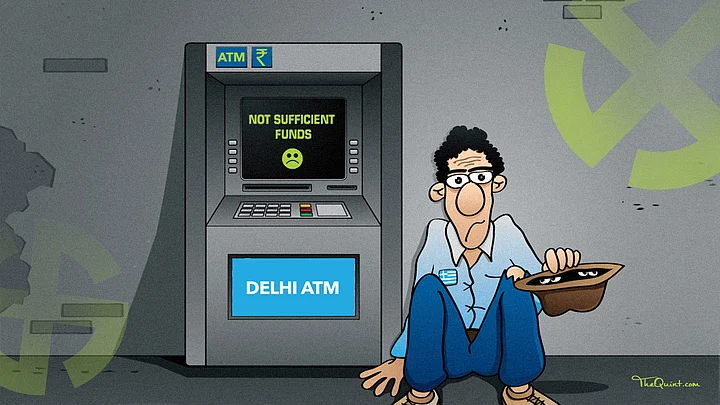If you’re in Mumbai, Delhi, Kolkata or Bangalore you may have been hit by a second round of notebandi from the first week of February. Between Thursday, 9 February and Monday, 13 February, I went around south Delhi locations like Yusuf Sarai, Hauz Khas, Safdarjung, Deer Park, Defence Colony and South Extension to locate one active cash dispensing machine. In vain.
If that’s been your experience too, blame elections in Uttar Pradesh, Uttarakhand, Punjab, Manipur and Goa and the BJP’s botched attempt to play demonetisation as an election gambit.
No Relief Despite Increase in Withdrawal Limit
Why? India’s central Bank, the Reserve Bank of India (RBI) is mum. The RBI issued more than 61 notices and circulars, which often contradicted each other, between 8 November and 30 December. On 16 January 2017, it magnanimously allowed you to pull out Rs 10,000 from an ATM account per day, provided you didn’t withdraw more than Rs 24,000 per week.
That should have come as a relief to folks in cities, which hog the vast majority of the 2.2 lakh ATM machines in India. (Rural India is home to nearly 70 percent of the population but has only 6.5 percent of all ATMs). Nevertheless once again, cities are choking under a cash crunch.
Meleveetil Damodaran, former head of India’s market regulator SEBI, and ex-boss of UTI and IDBI said, “With ATMs in some parts of India unable to meet demand, it is necessary to address the perception that supply of currency has been uneven across states.”
Pain Outweighs Gain from Note Ban
On 8 November, prime minister Narendra Modi abruptly withdrew 86 percent of currency by value out of the economy overnight. This led to an immediate cash crunch across the economy, slowing down harvests, fertilizer and tractor sales, industrial production and sales of consumer goods like soaps and cooking oil immediately.
The government claimed things would normalise by January, 2017. Modi pitched his ‘demonetisation’ scheme as a fight against terror funding, ‘black’ money – and finally, a drive to go cashless, in an economy where 92 percent to 95 percent of all economic transactions take place by cash. Cash withdrawals were limited by fiat; stringent penalties were imposed on those who would deposit old Rs 500 and Rs 1,000 notes after 30 December 2016.
The first phase of polls were held in Punjab and Goa on 4 February, and most observers agreed that the pain felt by the electorate from ‘notebandi’ was actually greater than the schadenfreude gains Modi wished to reap by portraying demonetisation as class war.
Demonetisation Turned into a Flop Show
Uttar Pradesh started polling from 11 February; by then, the BJP campaign had swerved from extolling the benefits of notebandi and diverted it to issues that involved caste and religious identity. The cash crunch, according to local leaders, was a vote-loser.
Akhilesh Yadav, the savvy young leader of the Samajwadi Party (SP), which is contesting polls against the BJP in alliance with the Congress, said as much in his first rally in UP’s Sultanpur, 24 January, when he said ‘notebandi’ had destroyed farmers’ and poor peoples’ livelihoods.
The rate of printing new currency to replace more than Rs 15.5 lakh crore worth of old notes taken out of circulation is flagging. More than three months after ‘notebandi’ only around half the total sucked out has been pumped back.
Economy in Disarray Due to Cash Crunch
Former finance minister Palaniappan Chidambaram reckons it will take till September this year to restore full currency supply. A former deputy governor of the RBI says, “The minimum is 120 days from now, or June this year.”
The currency shortage has caused economic disruption – with rural India complaining about inability to pay school or medical bills, and vegetable crops going waste – notebandi is no longer a Robin Hood vote catcher. Hence the BJP’s determination to disown it, and pump scarce cash only where it makes electoral sense.
A muzzled RBI refuses to give data about exactly how much cash was being dispensed across which regions of India, and when. This, despite requests from Bengal finance minister Amit Mitra, activists, NGOs and economists.
‘RBI Has Chosen to Crawl’
“This violates fundamental principles of independent central banking,” said a former governor of the RBI, on condition of anonymity.
This is frightening: if institutions like finance and banking are turned into tools of political and electoral expediency, then the scope of democracy will be narrowed by coercion and intimidation at all levels.
The former RBI governor added, “To paraphrase LK Advani’s famous comment about media during the Emergency, the RBI today has chosen to crawl when it was just asked to bend.”
(The writer is a Delhi-based senior journalist. He can be reached @AbheekBarman. This is an opinion piece and the views expressed above are the author’s own. The Quint neither endorses nor is responsible for the same.)
